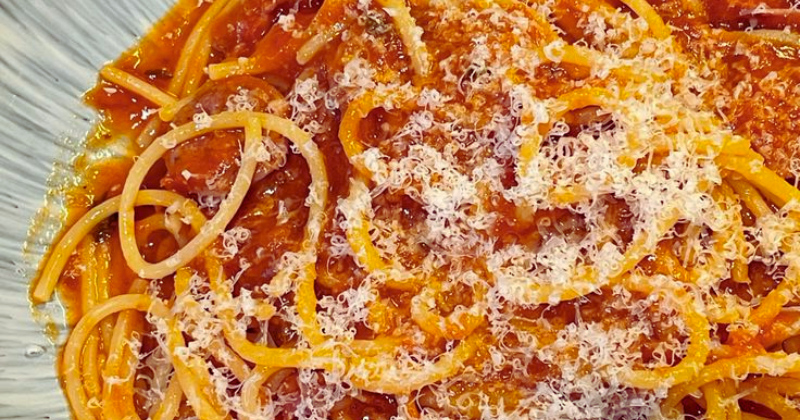Prep Time: 20 minutes | Cook Time: 3 hours | Total Time: 3 hours 20 minutes | Serves: 6-8 | Difficulty: Intermediate
Table of Contents
The first time I attempted spaghetti Bolognese in my tiny college apartment, I thought I could shortcut the process with jarred sauce and ground beef browned in ten minutes. The result was edible but forgettable – nothing like the rich, soul-warming dish I’d experienced during a semester abroad in Bologna, Italy. It wasn’t until my Italian host mother, Nonna Teresa, invited me into her kitchen for a proper lesson that I understood the magic of true Bolognese. She taught me that authentic spaghetti Bolognese isn’t just a meal – it’s a meditation, a labor of love that transforms simple ingredients into liquid gold through patience and technique. This traditional recipe honors her teachings and will fill your home with the most incredible aromas while creating memories that last a lifetime.
Why You’ll Love This Authentic Spaghetti Bolognese Recipe
This homemade Bolognese sauce delivers restaurant-quality results that will make you question why you ever settled for store-bought alternatives. First, the depth of flavor achieved through slow-simmering creates layers of complexity that develop over hours – each spoonful reveals new notes of sweetness, richness, and umami that dance on your palate. Second, this family-friendly recipe scales beautifully and freezes perfectly, making it ideal for meal prep enthusiasts who want gourmet meals ready at a moment’s notice. Third, the cooking process is surprisingly meditative and therapeutic – the gentle bubbling and stirring provide a wonderful excuse to slow down and embrace the art of cooking. Fourth, using authentic Italian techniques and ingredients creates an impressive dinner party centerpiece that guests will rave about for years. Finally, the versatility of this sauce extends far beyond pasta – use it for lasagna, stuffed peppers, or even as a pizza base, making it one of the most valuable recipes in your culinary arsenal.
Essential Ingredient Selection & Quality Guidelines
The foundation of exceptional spaghetti Bolognese lies in choosing premium ingredients that work in perfect harmony. Start with a blend of ground meats – traditional recipes use equal parts beef chuck, pork shoulder, and veal for optimal flavor and texture, though 80/20 ground beef and ground pork work beautifully as substitutes. San Marzano tomatoes are the gold standard, offering natural sweetness and low acidity that won’t overwhelm the meat’s richness, but high-quality whole canned tomatoes work well too. Fresh vegetables form the holy trinity of Bolognese: onions, carrots, and celery create the soffritto base that provides aromatic depth. Choose firm, bright carrots and crisp celery stalks, avoiding any with soft spots or wilted leaves. Whole milk adds crucial creaminess and helps tenderize the meat, while dry white wine contributes acidity that balances the richness. Fresh herbs like basil and oregano should be vibrant green with no brown spots, and always opt for freshly grated Parmigiano-Reggiano over pre-shredded alternatives. Store vegetables in the refrigerator’s crisper drawer and use within a week for optimal flavor. Quality olive oil and tomato paste in tubes rather than cans provide the finishing touches that separate good Bolognese from extraordinary.
Master the Essential Cooking Techniques
Creating perfect spaghetti Bolognese requires mastering four fundamental techniques that transform ordinary ingredients into culinary magic. First, building the soffritto properly sets the flavor foundation – dice vegetables uniformly and cook them slowly until they’re completely softened and translucent, which typically takes 8-10 minutes over medium-low heat. This patience allows natural sugars to develop and creates the aromatic base that permeates every bite. Second, browning the meat correctly is crucial for developing deep, complex flavors through the Maillard reaction. Cook the meat in batches to avoid overcrowding, which causes steaming instead of browning, and don’t rush this step – properly browned meat should develop a rich, caramelized exterior. Third, the wine reduction technique concentrates flavors and removes harsh alcohol notes. Allow the wine to bubble vigorously for 2-3 minutes until it reduces by half and the raw alcohol smell dissipates. Fourth, mastering the slow-simmer method is where the real magic happens – maintain the gentlest possible bubble, with only occasional surface movement, for 2-3 hours. This extended cooking time allows collagen to break down, creating silky texture while flavors meld and intensify.

Step-by-Step Cooking Instructions
- Prepare the Soffritto (10 minutes): Heat 3 tablespoons of olive oil in a heavy-bottomed Dutch oven over medium-low heat. Add 1 finely diced onion, 1 diced carrot, and 1 diced celery stalk. Cook slowly, stirring occasionally, until vegetables are completely soft and translucent. The kitchen should smell incredibly aromatic.
- Brown the Meat (12 minutes): Increase heat to medium-high and add 1 pound mixed ground meat (beef and pork). Break apart with a wooden spoon and cook until deeply browned, about 8-10 minutes. The meat should sizzle vigorously and develop rich, caramelized bits on the bottom of the pot.
- Add Tomato Paste (2 minutes): Push meat to one side and add 2 tablespoons tomato paste to the cleared space. Cook for 1-2 minutes until fragrant and slightly darkened, then stir into the meat mixture.
- Deglaze with Wine (5 minutes): Pour in ¾ cup dry white wine, scraping up any browned bits from the bottom. Let wine bubble vigorously until reduced by half and alcohol smell dissipates completely.
- Add Liquids and Seasonings (3 minutes): Stir in 1 cup whole milk, letting it simmer until mostly absorbed. Add 28 oz crushed San Marzano tomatoes, 1 bay leaf, salt, and freshly ground pepper. The mixture should come to a gentle simmer.
- Long Simmer (2-3 hours): Reduce heat to the lowest setting and partially cover. Simmer very gently, stirring every 30 minutes and adding warm water if needed. The sauce is ready when a wooden spoon dragged across the bottom leaves a clear trail that slowly fills in.
- Final Seasoning (5 minutes): Remove bay leaf, taste, and adjust seasonings. Stir in fresh basil leaves and a generous amount of freshly grated Parmigiano-Reggiano just before serving.
Professional Tips & Troubleshooting Solutions
Achieve Bolognese perfection with these insider secrets that professional chefs use to guarantee exceptional results. First, always cook pasta just shy of al dente when you plan to finish it in the sauce – this allows the pasta to absorb flavors while achieving perfect texture. Second, reserve a cup of starchy pasta water before draining; this liquid gold helps bind sauce to pasta and creates silky consistency. Third, if your sauce becomes too thick during the long simmer, add warm water or stock rather than cold liquid, which can shock the sauce and cause separation. Fourth, for even richer flavor, brown bones alongside the meat initially, then remove them before adding liquids – this technique adds incredible depth. Fifth, the “milk first” rule is crucial – always add milk before tomatoes to prevent curdling and ensure creamy integration. If your sauce tastes too acidic, add a pinch of sugar or grate in some carrot for natural sweetness. For sauces that lack depth, a parmesan rind simmered with the sauce adds umami richness that transforms the entire dish.
Creative Variations & Dietary Adaptations
Transform this classic spaghetti Bolognese to accommodate different dietary needs and flavor preferences without sacrificing authenticity. For a lighter version, substitute ground turkey and chicken for traditional meats, adding extra olive oil to compensate for lower fat content. Vegetarian versions work beautifully using finely chopped mushrooms, lentils, and walnuts to replicate the meat’s texture and umami depth. For gluten-free families, serve over rice pasta, zucchini noodles, or polenta instead of traditional wheat spaghetti. Those avoiding dairy can substitute full-fat coconut milk for regular milk and nutritional yeast for Parmesan cheese. Regional Italian variations include adding pancetta for extra richness or incorporating red wine instead of white for deeper color and flavor. To scale the recipe for larger gatherings, simply double all ingredients and extend simmering time to 3-4 hours, using a larger pot to maintain proper evaporation rates.
Storage, Make-Ahead & Freezing Guidelines
Bolognese sauce’s exceptional storage capabilities make it perfect for meal planning and busy weeknight dinners. Store cooled sauce in the refrigerator for up to 5 days in airtight containers – the flavors actually improve as they meld together over time. For optimal reheating, warm gently over low heat, adding a splash of water or stock if needed to restore proper consistency. The make-ahead potential is remarkable: prepare the sauce completely up to 3 days in advance, storing it refrigerated until ready to serve. For long-term storage, freeze portions in freezer-safe containers for up to 6 months, leaving space for expansion. Freeze in various portion sizes – single servings for quick lunches and family-size portions for complete dinners. Thaw frozen sauce overnight in the refrigerator, then reheat slowly over low heat, stirring frequently. Never refreeze previously frozen sauce, and always bring reheated sauce to a full simmer before serving for food safety.
Perfect Pairings & Elegant Presentation
Elevate your spaghetti Bolognese beyond the ordinary with thoughtful accompaniments and restaurant-style presentation techniques. The classic pairing remains spaghetti or tagliatelle, but pappardelle’s wide ribbons showcase the sauce beautifully for special occasions. Create an authentic Italian experience with warm, crusty bread for sopping up every precious drop of sauce. A simple arugula salad dressed with lemon vinaigrette provides refreshing contrast to the rich sauce, while roasted vegetables like zucchini or eggplant complement the meal’s rustic nature. For wine pairings, medium-bodied reds like Chianti Classico, Sangiovese, or Barbera d’Alba enhance the sauce’s depth without overwhelming it. Garnish individual servings with freshly torn basil leaves, a generous shower of Parmigiano-Reggiano, and a drizzle of your finest olive oil. For dinner parties, serve family-style in a large, warm bowl with pasta tongs and encourage guests to help themselves – this creates the convivial atmosphere that makes Italian dining so special.
Conclusion
This authentic spaghetti Bolognese recipe represents more than just dinner – it’s a connection to Italian culinary tradition and a testament to the transformative power of patience in cooking. While the three-hour simmer might seem daunting in our fast-paced world, the actual hands-on time is minimal, and the results are absolutely extraordinary. Each batch becomes better as you develop your technique and understand how the sauce should look, smell, and taste at every stage.
The beauty of mastering Bolognese lies not just in the incredible flavors, but in the way it brings people together. There’s something magical about serving a sauce that’s been lovingly tended for hours, watching faces light up with that first bite, and knowing you’ve created something truly special from simple, honest ingredients.
Ready to begin your own Bolognese tradition? Gather these ingredients, clear your afternoon, and prepare to fill your home with the most incredible aromas. Don’t forget to share your results – we love seeing how this timeless recipe continues to create new memories in kitchens around the world!

